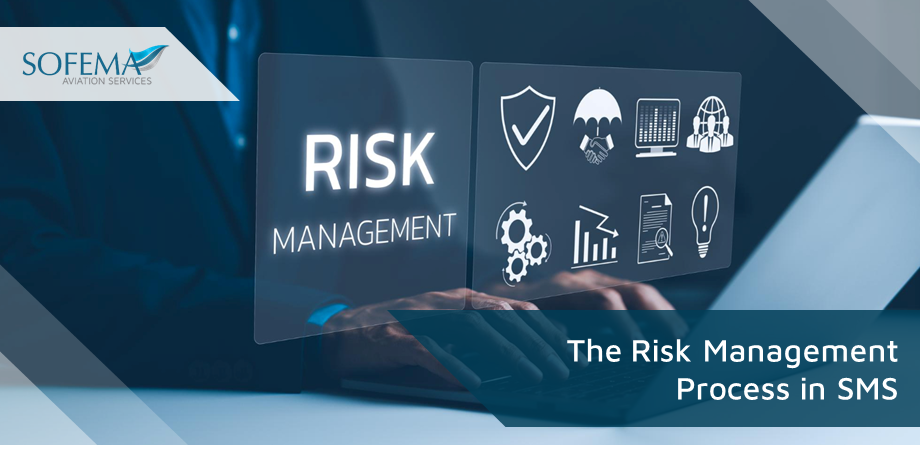Sofema Aviation Services (SAS) www.sassofia.com considers the Risk Management Process within an Aerodrome Safety Management System.
Effective risk management in an SMS requires a structured, continuous, and inclusive process that identifies hazards and evaluates and prioritizes risks based on their potential impact. By adopting a systematic approach, integrating risk management into broader decision-making processes, and ensuring that strategies are continuously updated and improved, organizations can better manage safety risks and allocate resources to mitigate potential hazards efficiently.
Introduction – A Safety Management System (SMS) is an organized approach to safety management that includes the necessary organizational structures, accountabilities, policies, and procedures.
- Safety Risk Management (SRM) is a key component of SMS. It focuses on identifying, evaluating, and mitigating risks associated with safety, separate from financial or legal risks.
Key Components of the Risk Management Process in SMS
Hazard Identification
- Description: The process begins with identifying hazards—any condition that could cause harm, damage, or a negative outcome.
- Challenges: One common pitfall is that organizations may stop identifying hazards and fail to analyze them fully or leap straight to mitigation without proper evaluation.
- Best Practice: Hazards should be identified using a systematic and proactive approach. This can involve tools such as checklists, safety audits, incident reports, and safety data analysis. Ensure inclusivity by engaging employees across all levels and departments for a more holistic view of hazards.
Risk Assessment and Evaluation
- Description: After identifying hazards, the next step is to assess and evaluate the associated risks. This involves determining both the likelihood of the hazard occurring and the severity of its consequences.
- Challenges: Organizations often fail to evaluate risks thoroughly because they bypass prioritization or don’t adequately quantify them.
- Best Practice: Use risk matrices or risk scoring methods to assess hazards. This step allows for prioritizing risks based on their likelihood and potential severity. The evaluation process should include:
– Likelihood: How probable is the occurrence of the hazard?
– Severity: What is the potential damage or harm from the hazard? Assessments should consider direct and indirect consequences and all available data, including historical safety records and expert opinions.
- Risk Mitigation
– Description: Once hazards have been evaluated and prioritized, appropriate mitigation strategies should be implemented to manage and reduce risks. The goal is to eliminate or reduce the hazard’s likelihood or severity.
– Challenges: Skipping the evaluation phase and jumping straight to mitigation without understanding the risks can result in misallocated resources.
– Best Practice: Mitigation measures should be tailored to the organization and the specific risk profile. This could include procedure changes, enhanced training, engineering controls, or redesigning systems. It’s crucial to allocate resources effectively based on the severity of the risks.
- Implementation and Monitoring
– Description: Mitigation plans must be implemented and continuously monitored to ensure effectiveness.
– Challenges: If mitigation strategies are not followed up with ongoing monitoring, their effectiveness cannot be ensured. Risks may also evolve, so keeping track of any changes is essential.
– Best Practice: Continuously monitor risks and mitigation efforts through audits, reviews, and feedback loops. Collect performance and safety metrics data to evaluate whether risk levels are reducing as expected. The SMS should have mechanisms to update and improve mitigation strategies as conditions change.
- Feedback and Continuous Improvement
– Description: The SRM process should be dynamic and capable of responding to new information or environmental changes. Risk management is not a one-time event but a continuous improvement cycle.
– Challenges: One-time risk mitigation without an iterative process may lead to outdated risk management strategies that fail to address evolving risks.
– Best Practice: Establish an iterative feedback loop that includes regular reviews of safety data and risk assessments. Engage employees in the evaluation process and create a culture of continuous improvement.
- Best Practices in Safety Risk Management
– Create Value: The risk management process should create value for the organization, ensuring that resources are allocated to prevent losses and enhance safety.
– Integration with Organizational Processes: Risk management should not be siloed. It needs to be integrated into decision-making processes across the organization so that safety becomes a factor in all major decisions.
– Explicitly Address Uncertainty: Acknowledge the uncertainties and assumptions that exist when assessing risks. Using data-driven methods and expert judgment can help in creating more accurate risk assessments.
– Systematic and Structured Approach: Risk management processes should be repeatable, consistent, and based on established frameworks or methodologies. Ad-hoc or reactive approaches can lead to oversight.
– Human Factors: Consider the role of human factors in risk management, including how human errors or limitations can contribute to risks. Mitigation strategies should include training and awareness programs to address human factors.
– Transparency and Inclusiveness: Effective risk management requires organisational transparency and inclusion. Engage different departments and levels of staff, ensuring that everyone understands the risks and their role in mitigating them.
– Dynamic and Iterative Process: Risk management should be dynamic and evolve as new data, hazards, and risks emerge. To remain relevant and practical, the process should include periodic reviews and updates.
Tailorability: The risk management process must be adaptable to the organization’s specific needs and unique risk profile.
- Common Challenges in Safety Risk Management
– Jumping to Mitigation: As noted, one of the most frequent mistakes is jumping directly to mitigation without proper risk assessment and prioritization. This can lead to misaligned efforts and wasted resources.
– Lack of Measurement: “You can’t manage what you can’t measure” is particularly true for intangible safety risks. Quantifying risks through metrics and assessment tools is essential for effective management.
– Siloed Risk Management: Safety risk management should not be isolated from other organizational processes. For instance, finance, operations, and human resources should all consider safety risks in their decision-making processes.
– Failure to Account for Human Factors: Many safety risks stem from human factors, including fatigue, cognitive limitations, or lack of training. Ignoring these elements can lead to ineffective risk management.
Next Steps
Follow this link to our Library to find & download related documents for Free.
If you have any comments or questions. Don’t hesitate to get in touch with team@sassofia.com
Tags:
Risk Assessment, Hazard Identification, SAS blogs, Risk Mitigation, best practices, continuous improvement, Aviation Safety Management System (SMS), Risk Monitoring, Aviation Risk Management





